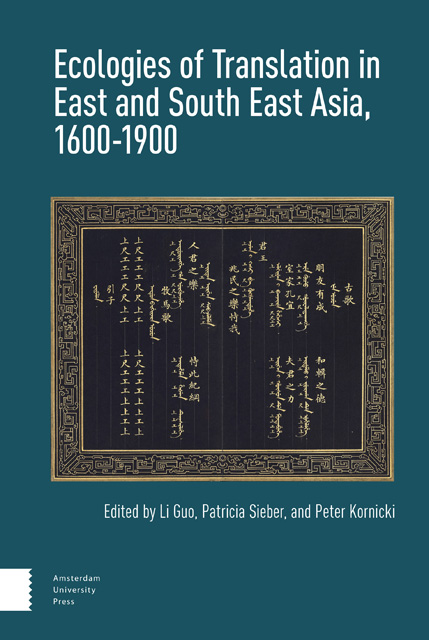Book contents
- Frontmatter
- Table of Contents
- Introduction: Scriptworlds, Vernacularization, and Shifting Translation Norms
- 1 On Not Being Shallow: Examination Essays, Songbooks, and the Translational Nature of Mixed-Register Literature in Early Modern China
- 2 A Faithful Translation: Tsūzoku sangokushi, the First Japanese Translation of Sanguozhi yanyi
- 3 Romance of the Two Kingdoms: Okajima Kanzan’s Chinese Explication of ‘The Annals of Pacification’ (Taiheiki engi)
- 4 Speaking the Sinitic: Translation and ‘Chinese Language’ in Eighteenth-Century Japan
- 5 ‘Body Borrowed, Soul Returned’: An Adaptation of a Chinese Buddhist Miracle Tale into a Vietnamese Traditional Theatrical Script
- 6 ‘Out of the Margins’: The Western Wing Glossarial Complex in Late Chosŏn and the Problem of the Literary Vernacular
- 7 Vernacular Eloquence in Fiction Glossaries of Late Chosŏn Korea
- 8 Imagined Orality: Mun Hanmyŏng’s Late Nineteenth-Century Approach to Sinitic Literacy
- 9 Linguistic Transformation and Cultural Reconstruction : Translations of Gorky’s ‘Kain and Artem’ in Japan and China
- Index
Introduction: Scriptworlds, Vernacularization, andShifting Translation Norms
Published online by Cambridge University Press: 16 November 2022
- Frontmatter
- Table of Contents
- Introduction: Scriptworlds, Vernacularization, and Shifting Translation Norms
- 1 On Not Being Shallow: Examination Essays, Songbooks, and the Translational Nature of Mixed-Register Literature in Early Modern China
- 2 A Faithful Translation: Tsūzoku sangokushi, the First Japanese Translation of Sanguozhi yanyi
- 3 Romance of the Two Kingdoms: Okajima Kanzan’s Chinese Explication of ‘The Annals of Pacification’ (Taiheiki engi)
- 4 Speaking the Sinitic: Translation and ‘Chinese Language’ in Eighteenth-Century Japan
- 5 ‘Body Borrowed, Soul Returned’: An Adaptation of a Chinese Buddhist Miracle Tale into a Vietnamese Traditional Theatrical Script
- 6 ‘Out of the Margins’: The Western Wing Glossarial Complex in Late Chosŏn and the Problem of the Literary Vernacular
- 7 Vernacular Eloquence in Fiction Glossaries of Late Chosŏn Korea
- 8 Imagined Orality: Mun Hanmyŏng’s Late Nineteenth-Century Approach to Sinitic Literacy
- 9 Linguistic Transformation and Cultural Reconstruction : Translations of Gorky’s ‘Kain and Artem’ in Japan and China
- Index
Summary
Introduction
In this volume we have brought together essays thatexamine various aspects of interlingual transactionswithin East Asia. Some of the essays stretch themeaning of the notion of ‘translation’ ininteresting and challenging ways and suggest thatRoman Jakobson's tripartite distinction betweenintralingual, interlingual, and intersemiotictranslation may need to be rethought. Part of thechallenge resides in the fact that, contrary to thenationalistically inflected binaries of ‘script’ vs.‘orality’ or ‘domestic’ vs. ‘foreign’ advanced intwentieth-century political and scholarlydiscourses, such categories prove to be remarkablyporous and permeable within the early modernlanguage ecologies of East Asia. Thus, this volumeis part of a broader conversation that seeks todismantle certain ready-made assumptions about thenature of the Chinese language, the Chinese literarycorpus, and the cultural engagement of countrieswithin the Sinographic sphere.
The need for a new mapping of the web of translationalinteractions becomes particularly acute as we takestock of the fact that early modern China's literaryculture operated in a plurality of linguistic forms.Moreover, these varieties of written Chineseexceeded the reformist May Fourth divisions betweenlanguages that were reputedly ‘outmoded’ or ‘new’,‘dead’ or ‘alive’. As Chinese intellectuals soughtto fashion a new written medium that couldaccommodate modern content and be readily learned bya mass public, they divided written Chinese intoso-called ‘literary’ (wenyan文 言) Chinese and ‘vernacular’(baihua 白話) Chinese,while revamping the entire literary canon to alignwith these new linguistic divisions. ‘LiteraryChinese’ was reputedly divorced from any spokenforms, encompassed the bulk of the Confucianclassics and the much-maligned examination essays,and as such was thought to represent a ‘deadlanguage’ that impeded modernization. The‘vernacular’ allegedly hewed closely to a spokenidiom, was newly aligned with the ostensibly‘popular’ forms of traditional fiction, drama,songs, and some poetry, and represented thefoundation upon which a new written standard couldbe established.
However, as more recent scholarship has shown, thisopposition between ‘literary’ and ‘vernacular’Chinese is profoundly misleading becausehistorically, the so-called ‘vernacular’ was neitherthe proximate counterpart to any spoken form ofChinese nor was it an exclusively popular form ofwriting. On the contrary, what distinguished thisform of writing – which has alternatively beencalled ‘vernacular’, ‘plain Chinese’, or‘mixed-register literature’ – was its encyclopediccapacity to blend registers drawn from differentstrata within literary Chinese.
- Type
- Chapter
- Information
- Publisher: Amsterdam University PressPrint publication year: 2022

